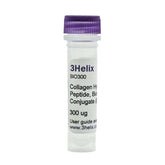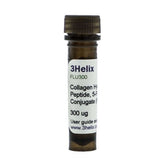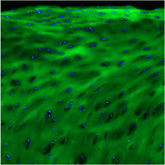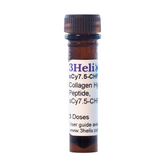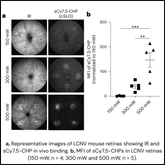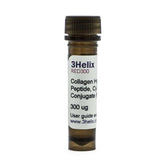CHPs as Targeting Drug Delivery Agent in Osteoarthritis
Osteoarthritis (OA), a debilitating degenerative joint disorder, is characterized by progressive cartilage degradation. Current treatments for osteoarthritis focus on managing symptoms like pain and stiffness through medications (oral and topical), physical therapy, exercise, supportive devices, and sometimes joint injections or surgery in severe cases, with currently no cure to reverse cartilage damage. In the early stages of the disease, collagen, a major cartilage component, begins to denature at the cartilage surface. Scientists recognized this early disease phenotype as an opportunity to develop a novel treatment to stop disease progression. The proposed therapeutic, CHP-KGN-An, consists of a capsule of albumin nanoparticles (An) conjugated to collagen hybridizing peptides (CHP) containing kartogenin (KGN) for a drug delivery method that specifically targets damaged collagen in the joint.

Kartogenin, a small molecule drug, has previously been found to increase chondrocyte differentiation among stem cells and reduce inflammation. However, due to its hydrophobic nature and potential to induce abnormal proliferation in healthy tissues, its therapeutic effect has been limited. Albumin nanoparticles were used to encapsulate KGN and increase the water solubility of the drug. The use of CHP allows the drug to specifically target sites of early OA formation through binding to damaged collagen, with minimal non-specific binding within healthy joint tissue, limiting the undesirable off-target effects of KGN.
Continue Reading
Kartogenin, a small molecule drug, has previously been found to increase chondrocyte differentiation among stem cells and reduce inflammation. However, due to its hydrophobic nature and potential to induce abnormal proliferation in healthy tissues, its therapeutic effect has been limited. Albumin nanoparticles were used to encapsulate KGN and increase the water solubility of the drug. The use of CHP allows the drug to specifically target sites of early OA formation through binding to damaged collagen, with minimal non-specific binding within healthy joint tissue, limiting the undesirable off-target effects of KGN.
In conclusion, this study provides compelling evidence that leveraging the collagen-targeting specificity of CHPs to deliver chondrogenic agents via albumin nanoparticles represents a promising therapeutic strategy for early-stage OA. Considering that damaged collagen is a characteristic feature across numerous diseases, collagen hybridizing peptides (CHPs) hold significant promise as a targeted therapeutic delivery system in a wide range of applications, enabling localized drug delivery or diagnostic imaging at sites of disease. While these are promising results in animal models, further research is needed to confirm their effectiveness and safety in humans. However, this work offers an exciting glimpse into the future of targeted therapies for this common and often debilitating condition.
FULL PAPER: Fei, Yuxiang, et al. "Promoting chondrogenesis by targeted delivery to the degenerating cartilage in early treatment of osteoarthritis." Bioactive Materials 40 (2024): 624-633.
